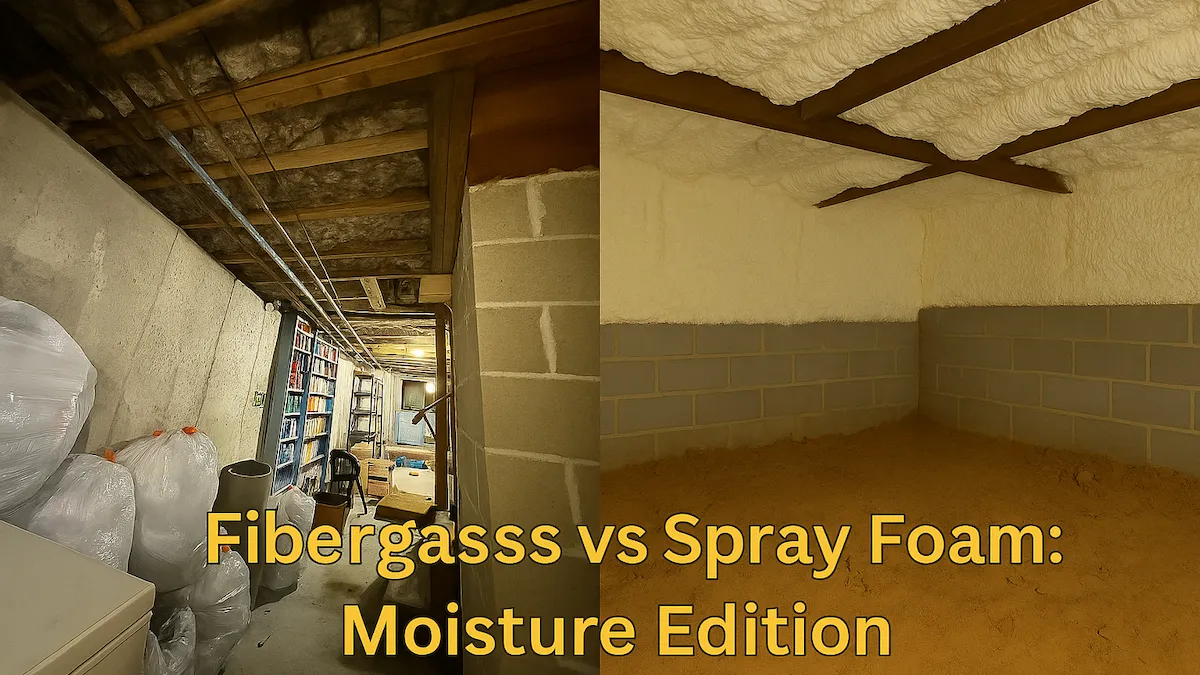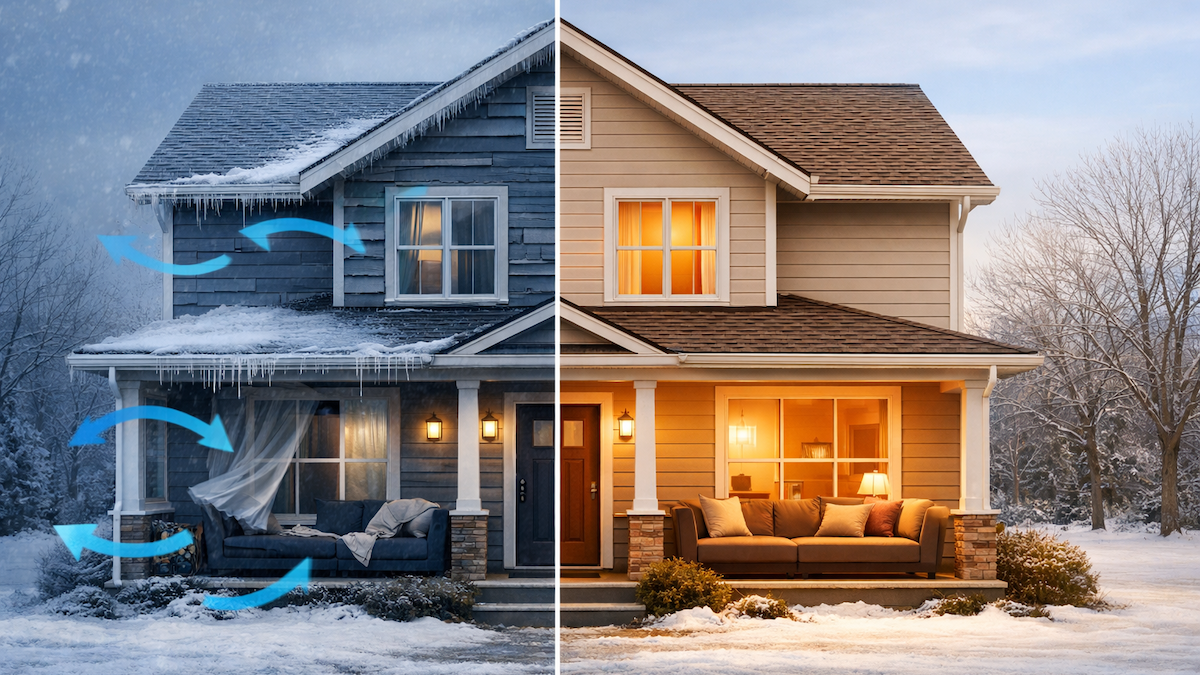How Does Blown-In Fiberglass Compare to Spray Foam in Moisture Resistance?

If you’ve ever walked into your basement after a rainy week and caught a whiff of that musty, damp smell—you already know why moisture resistance matters. Insulation isn’t just about keeping warm in the winter or cool in the summer. It’s also your home’s first line of defense against hidden water damage, mold, and air quality issues.
That brings us to a common showdown in the insulation world: blown-in fiberglass vs spray foam moisture resistance. Both materials get tossed around as “energy-saving” upgrades, but only one holds its ground when things get wet.
In this post, we’re breaking down how each insulation type performs when moisture enters the picture—whether it’s humid air, condensation, or a good ol’ New England nor’easter working its way through your walls. We’ll compare absorption rates, mold resistance, and where each one works best in a real Connecticut home.
Let’s get into it.
Understanding Moisture Resistance in Insulation
When we talk about moisture resistance in insulation, we mean how well a material handles water—whether from a leaky roof, humid summer air, or condensation inside your walls.
Why does that matter? Because moisture is the silent killer of comfort and efficiency. It soaks into your insulation, wrecks its R-value, invites mold, and can even rot out your framing. If your insulation acts like a sponge, you’re basically paying to heat or cool a pile of mildew.
Good moisture resistance means:
- No soggy insulation dragging down performance
- Less risk of mold and mildew
- Better indoor air quality
- A longer-lasting thermal barrier
Whether you’re insulating an attic in Guilford or a crawl space in Old Saybrook, understanding how different materials deal with moisture can save you a serious headache down the line.
Blown-In Fiberglass: Pros and Cons for Moisture
Blown-in fiberglass is the fluffy white stuff you’ll see in attics or walls—lightweight, quick to install, and relatively affordable. But here’s the catch: it’s not built to handle moisture.
The Moisture Problem
Fiberglass doesn’t exactly invite mold, since it’s not organic. But it does absorb and hold moisture, which creates the perfect damp, musty environment mold loves. Once it gets wet, fiberglass insulation:
- Loses R-value (up to 50%)
- Slumps or settles in cavities
- Traps moisture against wood framing
- Can make your attic or basement smell like a gym bag
We’ve seen it all over Connecticut—moisture issues with fiberglass insulation are common in homes with poor air sealing, roof leaks, or just a little too much summer humidity.
Where It Can Work
To be fair, blown-in fiberglass does just fine in dry, ventilated spaces—think attics with plenty of airflow and no risk of leaks. But in moisture-prone areas, like basements, crawl spaces, or rim joists? It’s not the material you want in your corner.
Spray Foam Insulation: Pros and Cons for Moisture
Now let’s talk spray foam—the tough, no-nonsense cousin of fiberglass. It expands to seal every crack, crevice, and air leak. And when it comes to moisture? Especially closed-cell spray foam? It’s in a different league.
Closed-Cell = Moisture Barrier
Closed-cell spray foam is dense and rigid—and doesn’t absorb water. It acts as its own vapor barrier, meaning it prevents moisture from getting in at all.
That means:
- No soaking, sagging, or slumping
- No mold growing behind the walls
- No hidden condensation issues
- Bonus: it adds structural strength
It’s the go-to choice for wet basements, crawl spaces, rim joists, or any area where moisture is a concern. It’s also ideal for Connecticut’s humid summers and snowy winters.
What About Open-Cell?
Open-cell spray foam is cheaper and more flexible, but it’s not water-resistant. It can absorb moisture, and it won’t block vapor movement the way closed-cell does. Not a great fit for moisture-prone areas.
Does Spray Foam Prevent Condensation?
Yes—closed-cell spray foam can actually help prevent condensation by sealing air leaks and eliminating the cold surfaces where water vapor would otherwise collect.
Head-to-Head Comparison: Fiberglass vs Spray Foam
Here’s how these two stack up side by side:
Bottom line: fiberglass can work if you control the moisture. But spray foam controls it for you.
Choosing the Right Insulation for Moisture-Prone Areas
So how do you actually choose the right insulation? Here’s how we do it in the field:
1. Where’s it going?
- Dry attic? Fiberglass may work just fine.
- Basement, crawl space, or anywhere with moisture risk? Spray foam wins.
2. What’s the climate?
Connecticut throws us heat, humidity, snow, and wind. That means your insulation needs to block moisture and air leaks year-round.
3. What’s the structure like?
Older homes with uneven framing? Weird little rim joists? Spray foam seals tight, even in tough spots where fiberglass fails.
4. What’s your budget—and your risk tolerance?
Fiberglass costs less up front but may need replacing if it gets wet. Spray foam costs more but lasts decades and protects from the start.
Common FAQ's About Fiberglass, Spray Foam and Moisture
Can I mix blown-in fiberglass and spray foam in different areas of my home?
Yes, you can mix blown-in fiberglass and spray foam in different areas of your home. Spray foam works best in damp or draft-prone spaces like rim joists and crawl spaces, while blown-in fiberglass is ideal for open, dry attics. Using both balances performance, air sealing, and cost efficiency.
Will moisture-resistant insulation help with musty smells in my basement?
Yes, moisture-resistant insulation helps reduce musty basement smells by blocking damp air and preventing condensation. Closed-cell spray foam seals rim joists and walls, keeping moisture out. When combined with air sealing and ventilation, it stops mold and mildew that cause odors and creates a drier, fresher space.
How can I tell if my current insulation has moisture damage?
Check for moisture damage in insulation by smelling for musty odors and looking for sagging, clumped, discolored, or moldy material. In fiberglass, moisture causes settling or compression. Rising energy bills or drafts can also signal trouble. Professionals use thermal cameras or moisture meters to confirm hidden damage.
Do I need a vapor barrier if I use spray foam?
You need a vapor barrier only if you're using open-cell spray foam. Closed-cell spray foam acts as its own vapor barrier due to its density and moisture resistance. Open-cell spray foam allows vapor through, so a separate vapor barrier is often required—especially in basements and crawl spaces in Connecticut.
Is moisture-resistant insulation worth the higher cost?
Moisture-resistant insulation is worth the higher cost in damp areas. Closed-cell spray foam offers insulation, air sealing, and vapor protection in one, preventing mold, rot, and future repairs. Though more expensive upfront, it delivers long-term savings, better energy efficiency, and improved indoor air quality—making it a smart investment in moisture-prone zones.
Final Verdict: Which Insulation Handles Moisture Better?
If moisture’s your concern—and let’s face it, it should be—closed-cell spray foam is your best bet. It blocks water, seals air, adds structure, and keeps you comfortable no matter what’s happening outside.
Blown-in fiberglass has its place, but only in dry, predictable environments. In damp or risky areas, it just doesn’t cut it.
Still not sure? Most insulation problems we see come from good intentions—but the wrong material in the wrong place. That’s why it pays to get it right the first time.
Related Articles
Let's Work Together
Ready to transform your home into an energy-efficient haven? Schedule your free energy assessment today and experience the Nealon difference for yourself.



